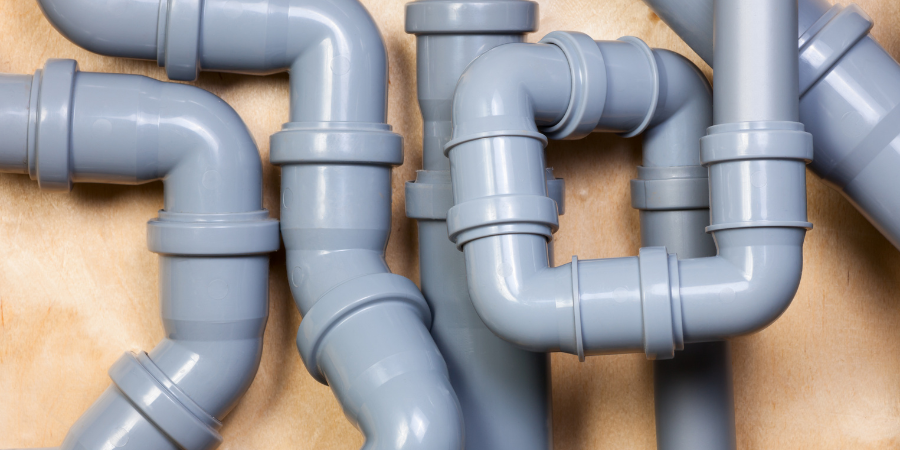You may be adding an addition to your home or looking to replace outdated plumbing materials already installed and are curious about the types of pipe materials available. Not every pipe can perform every function, so understanding the qualities of pipes can help when new plumbing is being added.
In this article, we will discuss the differences between cross-linked polyethylene (PEX) piping and traditional copper piping. We will learn about the different types available on the market and which type is best suited for certain applications. Finally, we will list the advantages and disadvantages of PEX and copper pipes to help homeowners better understand these pipe materials and select the pipe that works best for them.
Copper Pipe
Copper pipe has been the plumbing industry standard for decades, and for good reason. It is a long-lasting material resistant to many home conditions that can degrade plumbing pipes.
Types Of Copper Pipes
Copper piping is categorized by pipe thickness and ability to withstand conditions such as temperature and pressure. There are four types of copper pipe used in the plumbing industry.
Type K
Type K copper is the thickest of all the types and is identified by a green marking. Because of its thickness, it can withstand heavy pressure, so is frequently used for underground plumbing that must endure the weight of the soil above it. It is a good choice for outside water distribution lines.
Type L
This type of copper is frequently used for interior branch hot and cold water supply lines and exterior plumbing. It is available in rigid and flexible form and can be identified by a blue mark.
Type M
This type of copper pipe, known by its red markings, is the thinnest of all types and can be used in residential water supply lines. It is often less used than K or L, and in some parts of the country, it is outlawed by plumbing codes, so be certain to check your local regulations.
Yellow-Coded Copper
This type of copper was used mainly in Drain Waste Vent applications but has mostly been replaced by plastic PVC or ABS pipe. It carries a yellow marking for easy identification.
Pros Of Copper Pipe
Strength
Copper pipe is a durable product that can withstand high pressures with some types able to manage pressure as high as 1000psi. It has the added advantage of being strong enough to withstand high and low-temperature water and thus eliminates the threat of freezing pipes in areas where the weather is cold.
Longevity
Copper pipe enjoys a long life expectancy of between 50-70 years, depending on the type of copper, the climate, and the quality of the water being transferred.
Resistant
Copper pipe is fire resistant, unlike some plastic pipes that melt when exposed to fire. It is also resistant to the degrading other pipes undergo when exposed to ultraviolet light such as PVC and other plastic types.
Corrosion is a problem in plumbing pipes, but copper is considered corrosion-resistant, making it a good choice for areas with hard water.
Healthy
Copper pipe is considered a pipe that supports the health of the environment. First, because when it reaches the end of its productive life, it can be recycled.
Additionally, the manufacturing process to produce copper pipes is eco-friendly since there are fewer emissions and pollutants released into the air.
Finally, copper pipe does not leach chemicals or other harmful materials into the water so it provides healthier water to drink.
Cons Of Copper Pipe
The benefits far outweigh the cons of copper pipes, but there are a few disadvantages worth mentioning.
Cost
Metal pipes cost more than plastic pipes, and copper is the most expensive of the metal pipes. Its durability, resistance to corrosion, and ability to withstand ultraviolet light all come with a cost, and for many, the increased cost of copper is worth the investment.
Taste
Another disadvantage of installing copper pipes is it sometimes transfers a metallic taste to the water. While not a health risk, it can be offensive to some people.
Pinhole Leaks
Highly acidic water can negatively affect copper pipes. Over a long period of time, the pipes can develop small, almost undetectable pinhole leaks, which can create structural damage and mold-related issues.
PEX Pipe
PEX pipe, also known as cross-linked polyethylene. Has only been around since the early 1980s in the US but is a popular choice for many plumbing applications.
Types Of PEX Pipes
This product is made from high-density polyethylene heated and extruded into tubing of varying thicknesses or types.
PEX A
This type of PEX pipe is the most flexible and, thus, the most freeze-resistant of all three types. It is primarily used for water supply lines. It is produced using the peroxide or Engel method.
PEX B
This type of PEX pipe is used in swimming pool plumbing for the simple reason it resists chlorine which is found in pool water. This type of pipe uses the Silane or Moisture Cure method of production.
PEX C
Made using the Electronic Irradiation or Cold method, this type of PEX pipe is the most cost-effective, but it is prone to cracking if used in cold areas.
Pros Of PEX Pipe
PEX piping is corrosion-resistant and highly durable, making it a popular choice for plumbing applications. Here are some advantages to using PEX pipe.
Withstands Temperatures
This pipe has excellent thermal insulation and can manage hot water transfer. This is especially useful when the PEX is used for radiant floor heat.
Cost Effective
PEX piping is very cost-effective, especially when compared to more expensive copper. It also has the advantage of being able to be joined to other types of metal piping if the correct fitting is used. This reduces the costs associated with retrofitting a plumbing system.
Additionally, PEX pipe connections do not require chemical sealants, and they can be bent up to 90 degrees making the need for connections less likely than copper piping so they are less expensive to install.
Ease Of Installation
PEX is easier to install than copper pipe, and due to its flexibility it reduces the likelihood of noisy water hammer and instead supports the silent flow of water. Again, its flexibility also reduces the need for labor-intensive joining of pipe sections.
Cons Of PEX Pipe
Despite its popularity, there are some factors to consider making PEX a less desirable choice.
Special Requirements
PEX pipe requires specialized tools for installation, and special equipment means additional training to use it competently.
Harmful Effects
Although not used and tested long enough for a complete understanding of the effects of PEX piping, there is evidence that it can leach harmful chemicals into the water. This potentially harms the health of those with PEX pipes in their homes.
It is also harmful to the environment in that PEX pipe is not recyclable, and as a plastic, it takes many years to decompose.
Dangers
In addition to the harmful effects already discussed, PEX pipe is attractive to rodents since they can chew through the pipe to access the water and waste they need to thrive.
Another danger of PEX is that it will melt under high heat conditions, such as when a fire occurs, unlike copper pipe, which can withstand fires.
Need Help Choosing The Best Pipe Material For Your Home?
As seen, there are pros and cons of installing copper or PEX pipe when adding new plumbing or replacing outdated plumbing. It is difficult for homeowners to understand the full complexity of pipe materials and the conditions under which they can be ideally used so hiring a professional is a smart choice.
We understand plumbing and all the nuances associated with installing or replacing plumbing pipes, so we can advise you on what materials are best for your particular needs.
Feel free to call us to discuss your options, and together we can decide what is best to keep your home safe and your family comfortable by choosing the best product type available. Call us today to get started!
Need an emergency plumber in Orange County? Contact us today!






